In 1693, these premises were called The Green Dragon. By 1783, the inn had become The Swan, more formally The Swan With Two Necks. The name derives from the centuries-old tradition of marking birds’ beaks with nicks (or necks) to denote ownership. The early 19th-century extension at the rear of the premises was a grocery and provision store. It was later owned by the Leek and Moorlands Industrial Provident Society.
A photograph and text about the history of The Green Dragon.
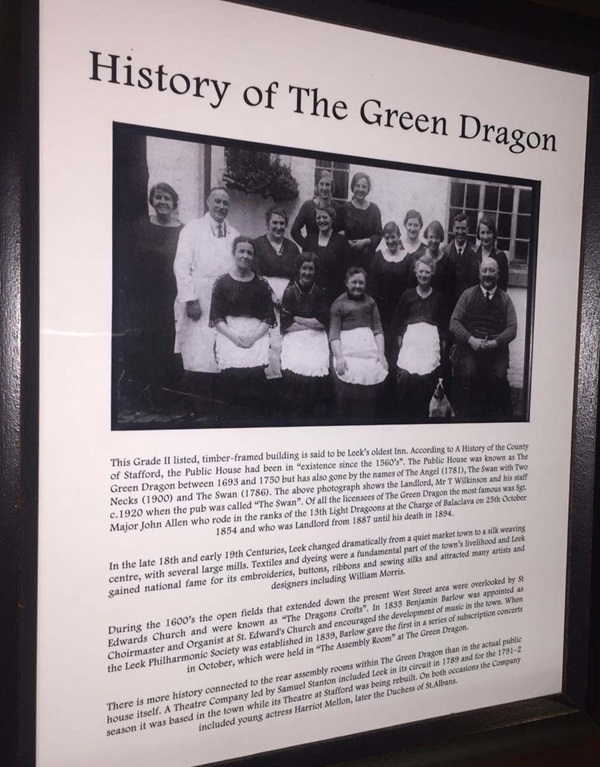
The text reads: This grade II listed, timber-framed building is said to be Leek’s oldest inn. According to A History Of the County of Stafford, the public house has been in “existence since the 1560s”. The public house was known as The Green Dragon between 1693 and 1750 but has also gone by the names of The Angel (1781), The Swan with Two Necks (1900) and The Swan (1786). The above photograph shows the landlord, Mr T Wilkinson and his staff c1920 when the pub was called The Swan. Of all the licensees of The Green Dragon the most famous was Sgt. Major John Allen who rode in the ranks of the 13th Light Dragoons at the Charge of Balaclava on 25 October 1854 and who was landlord from 1887 until his death in 1894.
In the late 18th and early 19th centuries, Leek changed dramatically from a quiet market town to a silk weaving centre, with several large mills. Textiles and dyeing were a fundamental part of the town’s livelihood and Leek gained national fame for its embroideries, buttons, ribbons and sewing silks and attracted many artists and designers including William Morris.
During the 1600s the open field that extended down the present West Street area were overlooked by St Edwards Church and were known as ‘The Dragons Crofts’. In 1835 Benjamin Barlow was appointed as choirmaster and organist at St Edward’s Church and encouraged the development of music in the town. When the Leek Philharmonic Society was established in 1839, Barlow gave the first in a series of subscription concerts in October, which were held in the Assembly Room at The Green Dragon.
There is more history connected to the rear assembly rooms within The Green Dragon than in the actual public house itself. A theatre company led by Samuel Stanton included Leek in its circuit in 1789 and for the 1791-2 season it was based in the town while its theatre at Stafford was being rebuilt. On both occasions the company included young actress Herriot Mellon, later the Duchess of St Albans.
Text about Leek Cattle Market.
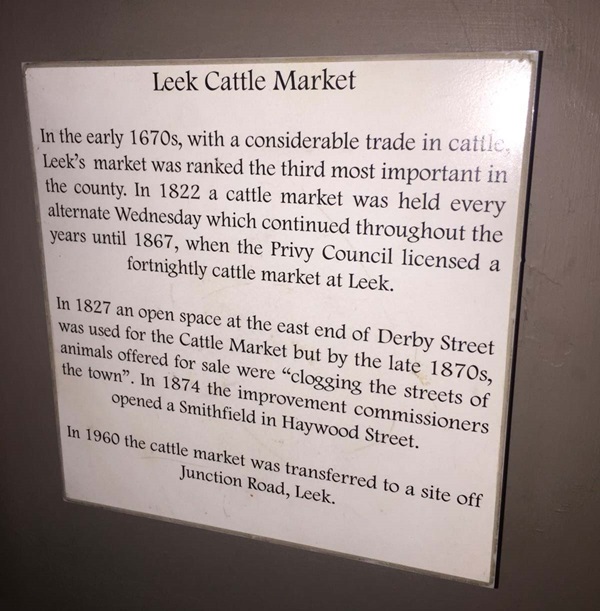
The text reads: In the early 1670s, with a considerable trade in cattle, Leek’s market was ranked the third most important in the county. In 1822 a cattle market was held every alternate Wednesday which continued throughout the years until 1867, when the Privy Council licensed a fortnightly cattle market at Leek.
In 1827 an open space at the east end of Derby Street was used for the cattle market but by the late 1870s, animals offered for sale were “clogging the streets of the town”. In 1874 the improvement commissioners opened a Smithfield in Haywood Street.
In 1960 the cattle market was transferred to a site off Junction Road, Leek.
A photograph and text about Jubilee Day Celebrations, Cattle Market, Leek, 1887.
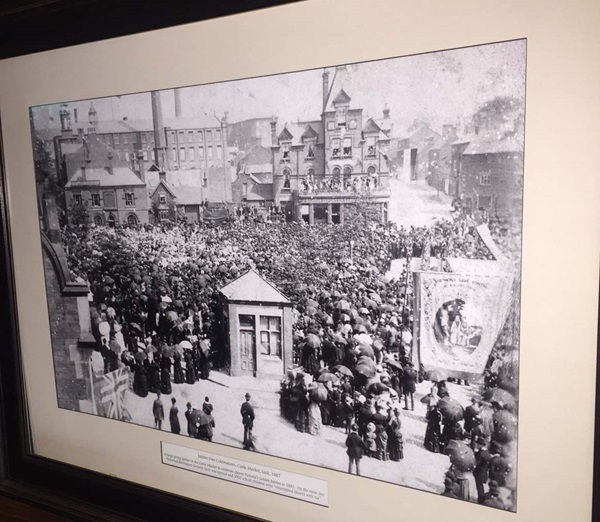
The text reads: A large group gather in the Cattle Market to celebrate Queen Victoria’s Golden Jubilee in 1887. On the same day Pickwood Recreation Ground, Leek was opened and 5000 school children were “entertained (there) with tea.”
A photograph and text about a steam bus outside Leek Railway Station, 1904.
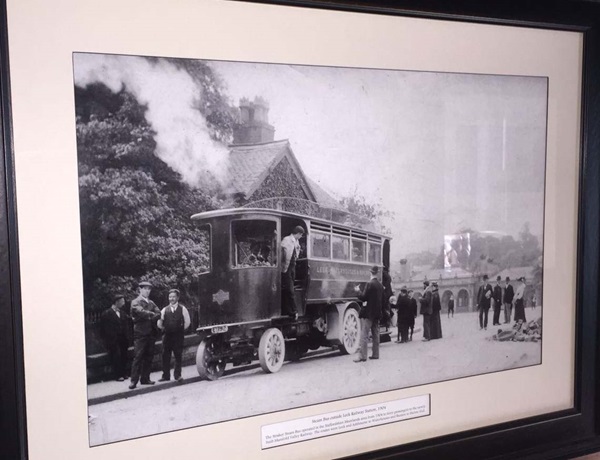
The text reads: The Straker Steam Bus operated in the Staffordshire Moorlands area from 1904 to ferry passengers to the newly built Manifold Valley Railway. The routes were Leek and Ashbourne to Waterhouses and Buxton to Hulme End.
Artwork entitled The Workhouse Infirmary, by Mark Lippett.
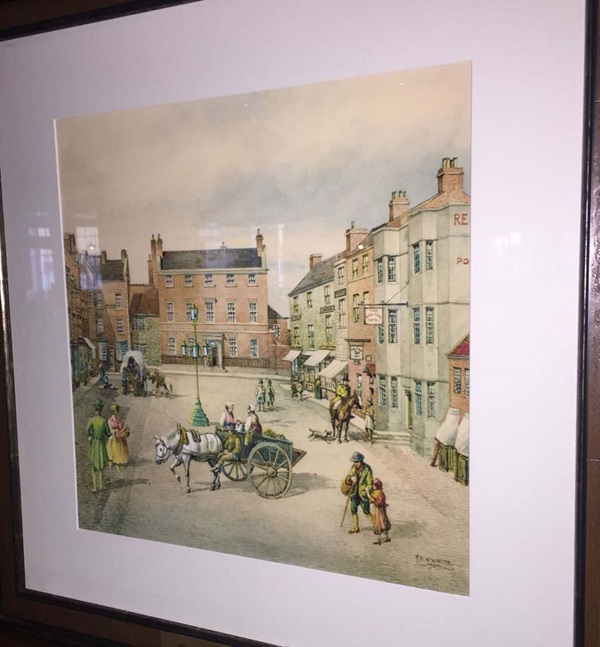
Mark works in various mediums and is mostly known for his paintings of derelict buildings. He draws inspiration from old abandoned buildings and his work captures the details and textures of the subject, which is built up with layers. He prefers to leave figures out of his work and focuses on the atmosphere of the location.
Mark studied Fine Art at Cumbria College of Art and Design and gained an MA in paintings at Wolverhampton University. He has exhibited his work in numerous group and solo shows across the UK and has taken part in numerous art competitions, winning the Open Art first prize at the Shire Hall Gallery in Stafford.
An illustration of the silk manufacturers Brough, Nicholson & Hall, Leek.
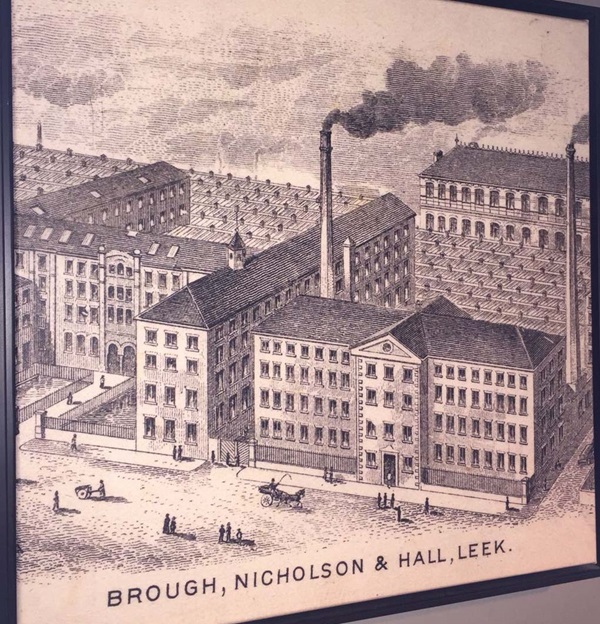
External photograph of the building – main entrance.
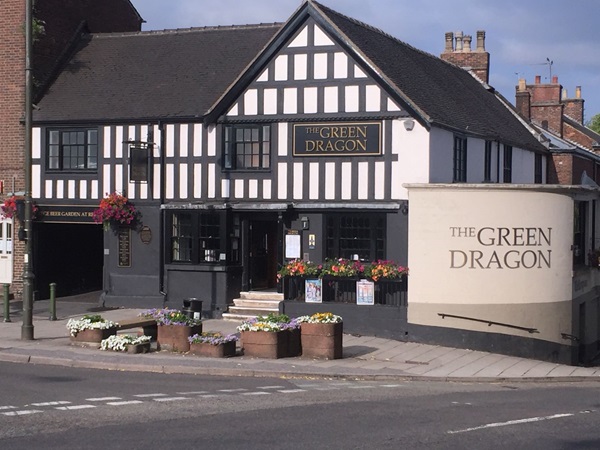
If you have information on the history of this pub, then we’d like you to share it with us. Please e-mail all information to: pubhistories@jdwetherspoon.co.uk